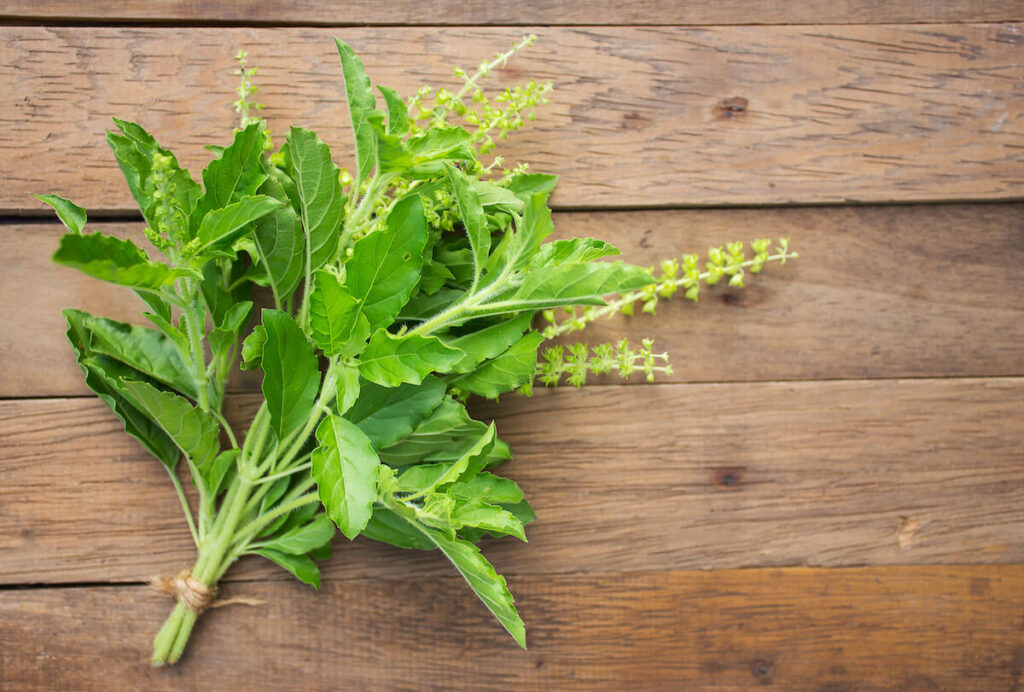
Holy basil, the queen of herbs, isn’t your average supermarket basil. It’s so much more.
The powerful adaptogen – a fancy way of saying “a substance that helps the body’s natural ability to deal with stress” – has been used for centuries in Ayurvedic practices to ease tension from the inside out.
If you find you get easily stressed, or that your skin isn’t the greatest, holy basil’s benefits very well could be the answer to those problems.
What is Holy Basil?
Holy basil, Ocimum sanctum, is an aromatic shrub in the basil family Lamiaceae that is believed to have originated from India (1✓)✓ Trusted ResourcePubMed CentralHighly respected database from the National Institutes of HealthRead source.
The herb is known as Tulsi in Hindi, Tulsai in Sanskrit, and Holy Basil in English.
Within Ayurveda, a holistic healing system developed more than 3,000 years ago in India, tulsi is known as “The Incomparable One,” “Mother Medicine of Nature” and “The Queen of Herbs.” It is revered as an “elixir of life” in regards to both its medicinal and spiritual properties.
While basil is found on every continent, holy basil is indigenous to the Indian subcontinent. It is a bushy shrub that grows 18 inches high with flowers in colors that range from light green to dark purple, depending on the variety. The herb also fruits later in the year, with fruits that consist of tiny rust-colored nuts.
There are four popular species of holy basil based on the regional religious beliefs in India:
- Rama tulsi (Ocimum sanctum) – green leaves
- Krishna tulsi (Ocimum tenuiflorum) – purple leaves
- Amrita tulsi (Ocimum tenuiflorum) – green leaves with purple highlights
- Vana tulsi (Ocimum gratissum) – dark green leaves
Emerging science on the health benefits of holy basil reinforces ancient Ayurvedic wisdom, suggesting that tulsi, when used as a tonic for the mind, body, and spirit offers solutions to many modern-day health problems.
Holy basil acts as an adaptogen, essentially meaning that it helps the body achieve a state of homeostasis allowing it to more effectively deal with stress.
The entire plant – leaves, roots, and stems – are used therapeutically, whether in tea, tinctures, tonics, pills, or juices.
Medicinal Properties of Holy Basil
The medicinal properties of holy basil have been studied in hundreds of scientific studies including in vitro, animal and human experiments.
These studies show that holy basil has a unique combination of actions that include (2✓)✓ Trusted ResourcePubMed CentralHighly respected database from the National Institutes of HealthRead source:
- Antimicrobial (including antibacterial, antiviral, antifungal, antiprotozoal, antimalarial, anthelmintic)
- Mosquito repellent
- Anti-diarrheal
- Antioxidant
- Anti-cataract
- Anti-inflammatory
- Chemopreventive
- Radioprotective
- Hepato-protective
- Neuro-protective
- Cardio-protective
- Anti-diabetic
- Anti-hypercholesterolemia
- Anti-hypertensive
- Anti-carcinogenic
- Analgesic
- Anti-pyretic
- Anti-allergic
- Immunomodulatory
- Central nervous system depressant
- Memory enhancement
- Anti-asthmatic
- Anti-tussive
- Diaphoretic
- Anti-thyroid
- Anti-fertility
- Anti-ulcer
- Anti-emetic
- Anti-spasmodic
- Anti-arthritic
- Adaptogenic
- Anti-stress
- Anti-cataract
- Anti-leukodermal
- Anti-coagulant activities
The key active constituents of holy basil that provide it with the above properties include (3✓)✓ Trusted ResourcePubMed CentralHighly respected database from the National Institutes of HealthRead source, (4✓)✓ Trusted ResourcePubMed CentralHighly respected database from the National Institutes of HealthRead source:
- Volatile oils like phenylpropanoids, terpenes, and eugenol (the key bioactive in tulsi)
- Phenolic compounds or flavonoids like orientin and vicenin
- Saponins
- Triterpenoids
- Tannins
- Vitamins C and A
- Minerals like calcium, iron, zinc, chlorophyll and other key phytonutrients
Spiritual Properties of Holy Basil
In Hinduism, tulsi is worshipped as a goddess and every part of the tulsi plant is revered and considered sacred, including the leaves, stem, flower, root, seeds and oil.
Even the soil surrounding the plant has been considered sacred and has recently been found to harbor beneficial fungi (5).
For these reasons and more, many Hindi households contain a tulsi plant, typically housed in a clay pot placed in a courtyard.
The wood or seeds of the holy basil plant are also used to make malas, which are strings of beads used to help the mind focus during meditation, chanting, or other devotional practices.
Culinary Uses of Holy Basil
Holy basil tastes nothing like the basil many are used to in the Western world. It is not as sweet, and the leaves are highly aromatic and have a peppery bite with notes of clove.
Holy basil tastes best when cooked, not when eaten raw. This is because it only fully releases its fragrance and flavour when cooked.
The herb is traditionally used in soups, stews, curries, oils, jellies, cheeses, and drinks like ‘liquid yoga’ which is used to bring about a sense of calm and clarity of thought.
Is Holy Basil the Same as Basil?
While holy basil and basil are both members of the same family, they are quite different in theory. There are over 40 different varieties of basil, and all are species of the genus Ocimum.
Holy basil has a sweet fragrance and basil has a spicy aroma. It is said that “regular” basil has a sweet taste, whereas holy basil tastes slightly more peppery and spicy.
You can cook with both types of basil, and receive plenty of antioxidants from both, but you’ll likely experience a calmer state of mind after cooking with holy basil.
Holy Basil Health Benefits
Holy basil benefits the body in numerous ways. It’s a herb I believe should be in everyones medicine cabinet so that you have it when in need.
The incredible antioxidant properties of this herb provide it with the following benefits:
1. May Help Prevent Cancer
Holy basil is rich in antioxidants and phytochemicals that help scavenge free radicals and slow the process of DNA damage that often leads to the development of cancer.
These phytochemicals like eugenol, rosmarinic acid, apigenin, myretenal, luteolin, β-sitosterol, and carnosic acid may prevent chemical-induced skin, liver, oral and lung cancers (6✓)✓ Trusted ResourcePubMed CentralHighly respected database from the National Institutes of HealthRead source. The protective effects include increasing antioxidant activity, altering healthy gene expressions, inducing cancer cell death, and inhibiting angiogenesis and metastasis, which is the spread of cancer from one organ to another.
Pre-clinical studies have shown that holy basil also protects against radiation damage by selectively protecting normal tissue against the destructive effects of radiation (7✓)✓ Trusted ResourcePubMed CentralHighly respected database from the National Institutes of HealthRead source.
2. Anti-Inflammatory
Another prime action of holy basil in cancer prevention comes from its ability to inhibit an enzyme called COX-2, which stimulates at inflammatory response in the body and triggers cancerous activities. By blocking the action of this enzyme, holy basil prevents inflammation and the associated pain response.
The anti-inflammatory effects of holy basil have been found comparable to non-steroidal anti-inflammatory drugs like phenylbutazone, ibuprofen, naproxen, aspirin and indomethacin (8), (9✓)✓ Trusted ResourcePubMed CentralHighly respected database from the National Institutes of HealthRead source, (10).
Some research has also found that when taken orally, concentrated extracts of holy basil – – Ocimum americanum and Ocimum tenuiflorum – reduced joint swelling by up to 73% within just 24 hours (11✓)✓ Trusted ResourcePubMed CentralHighly respected database from the National Institutes of HealthRead source.
The researchers suggest that eugenol, the oil that gives basil its distinctive aroma, is the active molecule responsible for its anti-inflammatory effects. But they then go on to further elaborate that other molecules in the plant are likely involved.
3. Supports Healthy Skin
The anti-bacterial and anti-fungal properties of tulsi can help kill the bacteria that cause breakouts and skin infections (12✓)✓ Trusted ResourcePubMed CentralHighly respected database from the National Institutes of HealthRead source. For this reason, it makes a great remedy for acne and other skin irritations, and can be used both internally and externally.
When incorporated into topical skincare, holy basil helps reduce inflammation, clears acne and brightens hyperpigmentation.
The adaptogenic properties of holy basil strengthen the body’s natural ability to resist stress, which is a major contributor to poor skin (13✓)✓ Trusted ResourcePubMed CentralHighly respected database from the National Institutes of HealthRead source. Cortisol tells glands in your skin to make more oil, and oily skin is more prone to acne and other skin problems. So the less stress you have, the better skin you’ll experience.
Another skin-enhancing benefit of holy basil is its ability to encourage collagen and elastin production. It contains the terpene linalool, which not only offers anti-stress benefits, but also aids in the production of vitamin E.
Vitamin E plays a huge role in skin health, helping protect collagen and elastin, which make up the structural layers of the skin. This helps reduce signs of aging on the skin like fine lines and wrinkles (14✓)✓ Trusted ResourcePubMed CentralHighly respected database from the National Institutes of HealthRead source.
4. Reduces Stress and Anxiety
Holy basil’s uncanny ability to lower cortisol levels makes it one of the top reasons most people turn to this herb to naturally relieve their stress and anxiety.
Holy basil is considered an adaptogenic herb, so it helps the body adapt to stress and reach a state of homeostasis.
The herb contains two phytochemical compounds, ocimumosides A and B, which may lower blood corticosterone (a stress hormone) levels to induce positive changes to the neurotransmitter system of the brain (15✓)✓ Trusted ResourcePubMed CentralHighly respected database from the National Institutes of HealthRead source. A third phytochemical called 4-allyl-1-O-beta-D-glucopyronosyl-2-hydroxybenzene has also been shown to lower stress parameters in the lab (16).
In a systematic review, ingesting tulsi supported traditional uses of this herb and prove effective in the treatment of psychological stress (17✓)✓ Trusted ResourcePubMed CentralHighly respected database from the National Institutes of HealthRead source.
Another study published in the Journal of Ayurveda and Integrative Medicine found that tulsi counters metabolic stress by normalizing blood glucose, blood pressure and lipid levels, and psychological stress (18✓)✓ Trusted ResourcePubMed CentralHighly respected database from the National Institutes of HealthRead source.
5. Protects Against Diabetes
Holy basil has been extensively studied for its ability to lower blood glucose levels, as well as high triglycerides and cholesterol that often accompany type II diabetes.
Out of all the chemical constituents in holy basil, the phytochemical eugenol has been found to have the greatest anti-hyperglycemic effect (19✓)✓ Trusted ResourcePubMed CentralHighly respected database from the National Institutes of HealthRead source.
Out of all the chemical constituents in holy basil, the phytochemical eugenol has been found to have the greatest anti-hyperglycemic effect (20✓)✓ Trusted ResourcePubMed CentralHighly respected database from the National Institutes of HealthRead source.
In one randomized placebo-controlled single-blind trial, patients with non-insulin-dependent diabetes experienced reduced fasting blood sugar levels, urine blood sugar levels, post-meal blood sugar levels as well as mean total cholesterol levels during their holy basil treatments (21✓)✓ Trusted ResourcePubMed CentralHighly respected database from the National Institutes of HealthRead source. The researchers concluded that tulsi may be used as part of a treatment plan for those with mild-to-moderate non-insulin-dependent diabetes.
6. Improves Oral Health
The antimicrobial properties of holy basil make it a great herb for improving oral health.
In one human clinical trial, tulsi essential oil toothpaste was compared with a triple antibiotic paste (ciprofloxacin, minocycline, and metronidazole) in a head to head study in 40 children over 3 days (22✓)✓ Trusted ResourcePubMed CentralHighly respected database from the National Institutes of HealthRead source.
They found that there was a statistically significant reduction in colony-forming units (CFUs) after using the tulsi essential oil, however, the triple antibiotic paste performed better.
With that being said, there might be a bit of a trade-off given that the antibacterial paste introduces problems of antibacterial resistance and can come with some undesirable side effects.
Some other desirable effects of holy basil in relation to oral health include halting the growth of oral cancer cells and helping to diminish ulcers in the mouth (23).
7. Supports Cardiovascular Health
There are multiple ways holy basil benefits cardiovascular health. As previously mentioned, the phytochemicals ocimumosides A and B help reduce stress and balance the neurotransmitters serotonin and dopamine in the brain. This natural reduction of stress hormones takes a great deal of pressure off the heart.
Studies have shown that high levels of cortisol from long-term stress can increase blood cholesterol, triglycerides, blood sugar, and blood pressure – all common risk factors for heart disease (24✓)✓ Trusted ResourcePubMed CentralHighly respected database from the National Institutes of HealthRead source.
By reducing blood levels of cortisol with adaptogenic herbs like holy basil, you can indirectly take the stress off the cardiovascular system too.
In addition, the anti-inflammatory properties of tulsi help reduce inflammation in the arteries and veins, therefore lowering blood pressure.
8. Balances Hormones
Tulsi possesses strong adaptogenic behavior, which influences hormone function and balance. By decreasing cortisol levels, it helps maintain a state of homeostasis in the body.
Holy basil also protects against chemical and environmental pollutants, which are major contributors to hormone imbalance.
9. Improves Respiratory Health
Holy basil has been used to treat lung conditions for centuries. It effectively liquefies the phlegm and is effective for cough due to allergic bronchitis, asthma and eosinophilic lung disease (25✓)✓ Trusted ResourcePubMed CentralHighly respected database from the National Institutes of HealthRead source.
Tulsi leaves contain phytochemicals like camphene, eugenol, and cineole, all of which provide relief from conditions involving the respiratory system. They act by assisting in congestion relief and fighting infections in the lungs thanks to their natural antibiotic properties.
Studies have even shown how holy basil is useful in the treatment and prevention of asthma. According to studies out of the University of Michigan, holy basil extracts helped open up and clear bronchial airway passages, making it easier for asthma patients to breathe and experience fewer attacks (26).
These studies found that tulsi extracts not only kept them clear but inhibited constriction of the bronchial airway.
10. Immune System Support
The high level of antioxidants, phytochemicals, and other nutrients found in holy basil makes it a great herb for helping bolster the immune system.
One small human study found that taking just 300 milligrams (mg) of holy basil leaf extracts for four weeks led to an increase in cytokines (27✓)✓ Trusted ResourcePubMed CentralHighly respected database from the National Institutes of HealthRead source. Cytokines are proteins that play a very important role in regulating our immune system. When released, they signal the immune system to do its job — so by increasing the concentration of cytokines in the bloodstream, holy basil improves our innate immune response.
Other aspects of holy basil, including its role in reducing inflammation and lowering cortisol levels in the body, also help take the stress off our immune system, making it stronger.
How to Use Holy Basil
Holy basil can be used in a variety of ways. It can be used in cooking, as a way to flavor water, or to make a delicious warm tea. You can alternatively use it therapeutically in tincture or supplement form.
Common Ways to Use Holy Basil:
Holy Basil Supplements: You can take holy basil in supplemental form, such as in tincture, extract or capsules. Follow the manufacturer’s guidelines for dosing.
Holy Basil Tea: If you want to make a tea out of holy basil, which is great to use before bedtime, then making a tea out of the dried herb is your best option. I like getting teas in bulk because then I can choose how much I want to add to my cup. Combine 1-3 teaspoons of dried leaves with hot water and let steep 5-10 minutes before removing the leaves. You can use a stainless steel tea infuser to make the process easier.
Holy Basil Essential Oil: Holy basil essential oil can be used topically when diluted with a carrier oil like jojoba or almond oil. You can also diffuse the oil in your home, that way you’ll receive all the calming and immune-boosting properties the herb has to offer.
Holy Basil in Cooking: Holy basil can also be used for culinary purposes. You can use it in stir-fries, soups, or stews. It tastes best when cooked instead of eaten raw.
There are a variety of ways you can use holy basil to your benefit. Depending on what your specific needs are, you can utilize holy basil simply for its culinary effects, or for its more therapeutic aspects.
Holy Basil Dosage
The dosage of holy basil you take will depend on a variety of factors like your current state of health and several other conditions.
Some studies have found that people who take between 250 and 600 milligrams (mg) of holy basil extract each day may experience an improvement in their mental health, inflammation, and digestion. Higher doses may be recommended for those who have more persistent symptoms. For example, taking 600 to 2,200 mg/day could be divided into 3 doses throughout the day for best results (28✓)✓ Trusted ResourcePubMed CentralHighly respected database from the National Institutes of HealthRead source.
According to the suggestions from herbalists in the books Adaptogens in Medical Herbalism and Adaptogens: Herbs for Strength, Stamina, and Stress Relief, it is recommended to take the following:
- Tea: 2-4 cups daily (1 teaspoon dried holy basil in 1 cup hot water. Steep 10 minutes).
- Tincture: for a 1:2 or 1:5 extract, take 40-60 drops three times a day.
- Standardized extract supplement: when it includes 2.5% solid acid, the dosing range is between 200 and 500 mg daily.
What Are the Side Effects of Holy Basil?
Holy basil has a pretty great safety profile, so most people can take it without experiencing negative side effects.
With that being said, some animal studies have found that relatively large doses of holy basil may stimulate uterine contractions, so caution should be used by those who are trying to get pregnant or are currently pregnant.
Tulsi may also impair blood clotting, so taking it along with medications that also slow blood clotting may increase the risk of bleeding and bruising. For this reason, try to avoid supplementing with the herb if you are currently taking any of the following: aspirin, clopidogrel, dalteparin, enoxaparin, heparin, ticlopidine and warfarin. It is also advised to avoid taking two weeks before any surgery, due to its impact on blood clotting.
The Bottom Line
Holy basil is a therapeutic calming herb that has been used for centuries in Ayurvedic Indian medicine. It is said to benefit mind, body and spirit, and science has, to some degree, proven a large majority of these effects.
Holy basil, or tulsi, helps support skin health, balances hormones and lowers stress, protects against diabetes, fights cancer, and more.
You can take holy basil in supplement form, as a tea, or cook with it. Whatever way you intend on using it, you’ll receive all the benefits it has to offer.
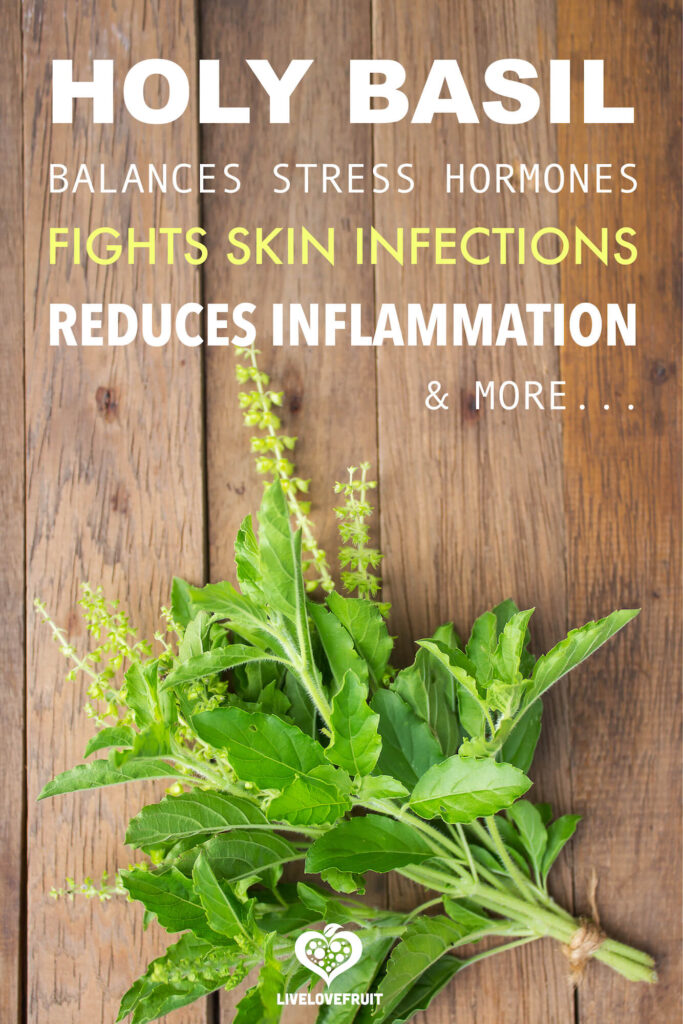


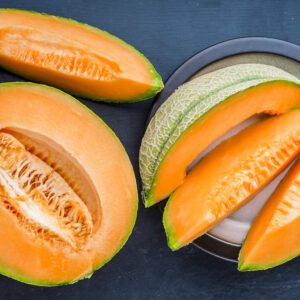

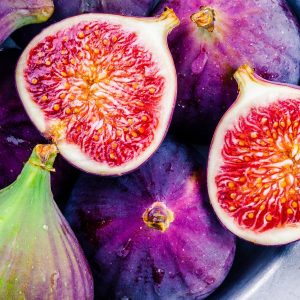
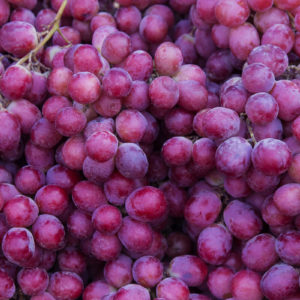
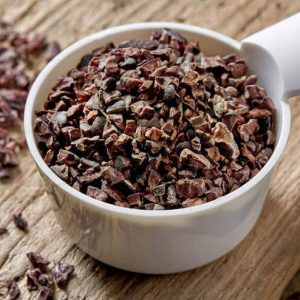

Where can one find Holy Basil to grow it? I’ve never seen it.
You should be able to find it at a local nursery, or you can purchase seeds online and grow yourself!
Etsy.com
Can you comment on how much content/mg may equate to 1 cup of Holy Basil tea?
Prepare contents: (India Organic brand – 1.8 g tea bag/8oz water), steep 5-8 mins.
I would like to know this to better determine the over-all daily dosage when using the tea along with a tincture which has the mg content listed on the bottle.
Thank You,
David
Hi David. Therapeutic dosing range for holy basil tea is 2 to 4 cups daily. Your tea bag should be enough to equate for that. I would contact the company to get more information on the exact mg, as each company is different.